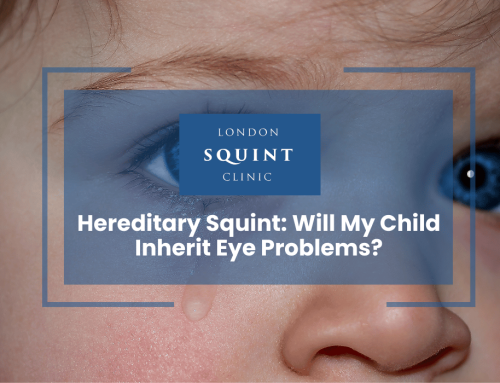Intermittent Squints in Kids: When to Worry and What to Do
Intermittent Squints in Kids
- Intermittent squints (strabismus) in children can be convergent (eye turns inward) or divergent (eye turns outward), with intermittent exotropia being most common.
- Warning signs include a child closing one eye when focusing, head tilting, complaints of headaches, or difficulty with depth perception.
- While occasional eye misalignment in babies under 6 months can be normal, persistent squints beyond this age require professional evaluation.
- Early intervention is crucial as untreated squints can lead to amblyopia (lazy eye) or permanent vision impairment.
- Treatment options range from glasses and vision therapy to patching and surgery, depending on the type and severity of the squint.
- Sudden onset squints, especially when accompanied by headaches, vomiting, or behavior changes, require immediate medical attention.
- Home management includes consistent use of prescribed glasses, following patching schedules, and performing recommended eye exercises.
- While squinting can sometimes occur in children with autism or other developmental conditions, it is not itself diagnostic of these conditions.
Table of Contents
- Understanding Intermittent Squints: Types and Causes in Children
- Recognizing the Signs: When Is a Child’s Squint Concerning?
- Age Matters: How Squints Present from Infancy to School Age
- Is My Child’s Squinting Related to Autism or Other Conditions?
- How Do Doctors Diagnose and Treat Intermittent Squints?
- Exploring Surgical Options: Timing and Expectations
- Home Management: Supporting Your Child with an Intermittent Squint
- When to Seek Immediate Medical Attention for Sudden Squints
Understanding Intermittent Squints: Types and Causes in Children
Intermittent squint in children, medically known as intermittent strabismus, is a condition where the eyes are not consistently aligned. Unlike constant squints, intermittent squints come and go, often triggered by specific circumstances such as tiredness, illness, or intense concentration. This variability can make them challenging for parents to identify and monitor.
There are two primary types of intermittent squints: convergent (esotropia) and divergent (exotropia). In convergent squints, the affected eye turns inward toward the nose, while in divergent squints, the eye deviates outward. Intermittent exotropia is the most common form in children, often becoming more noticeable when the child is tired, daydreaming, or looking at distant objects.
The causes of intermittent squints are multifaceted. Some children develop them due to refractive errors like long-sightedness, which requires extra focusing effort that can lead to eye misalignment. Others may have neuromuscular imbalances affecting the coordination of eye muscles. Genetic factors also play a role, with children of parents who had squints being at higher risk. Importantly, intermittent squints can sometimes signal underlying vision development issues that require timely intervention to prevent complications like amblyopia (lazy eye) or permanent vision impairment.
Recognizing the Signs: When Is a Child’s Squint Concerning?
Identifying an intermittent squint in your child requires careful observation, as the misalignment isn’t always obvious. Parents might notice their toddler squinting both eyes, particularly when the child is tired or unwell. One telltale sign is when your child closes or covers one eye while focusing on something, especially when watching television or reading. This behaviour often indicates the child is attempting to eliminate double vision caused by the misaligned eyes.
For a 1-year-old baby squinting eyes, you might observe momentary eye turns, especially when they’re trying to focus on something interesting. In older children, complaints of headaches, eye strain, or difficulty with depth perception (like misjudging distances when reaching for objects) can signal an intermittent squint. Some children may also tilt or turn their head consistently to compensate for vision problems.
A sudden squint in a child warrants immediate attention, as it could indicate a more serious underlying condition. While occasional eye misalignment in infants under six months can be normal as their visual system develops, persistent or recurring squints beyond this age should be evaluated by a specialist. Similarly, if you notice your 3-year-old squinting eyes frequently, particularly if accompanied by other symptoms like eye rubbing or complaints about vision, prompt assessment is essential.
Remember that children rarely complain about vision problems directly, as they often don’t realise their vision differs from normal. Therefore, regular vision screenings and attentiveness to subtle behavioural changes are crucial for early detection and intervention.
Age Matters: How Squints Present from Infancy to School Age
The presentation and implications of squints vary significantly across different developmental stages. In newborns and very young infants, occasional eye misalignment is common as their visual system and eye muscle coordination are still developing. However, consistent squinting beyond 3-4 months of age requires professional evaluation.
For a 1-year-old baby squinting eyes, parents might notice intermittent eye turns during focused activities or when the child is tired. At this age, squints can be related to developing visual pathways and may sometimes resolve naturally, but assessment is still recommended to rule out significant issues.
Toddlers (ages 1-3) with intermittent squints may demonstrate more obvious symptoms as visual demands increase. A toddler squinting both eyes might be compensating for vision difficulties, particularly when looking at books or distant objects. By this age, consistent squinting warrants prompt attention as the visual system is still highly plastic and responsive to intervention.
By preschool age (3-5 years), including the 3-year-old squinting eyes scenario, squints become more concerning as they can significantly impact visual development during this critical period. Children this age may begin to show functional difficulties, such as bumping into objects or struggling with activities requiring hand-eye coordination.
School-aged children with untreated squints often develop compensatory mechanisms that can mask the problem but may experience learning difficulties, particularly with reading and writing. They might report double vision or headaches after visual tasks. The longer a squint persists into school age, the more challenging treatment becomes, as the brain’s visual plasticity gradually decreases, making early intervention for eye alignment issues crucial for optimal outcomes.
How Do Doctors Diagnose and Treat Intermittent Squints?
Diagnosing an intermittent squint in children involves comprehensive eye examinations tailored to the child’s age and cooperation level. Pediatric ophthalmologists use specialised techniques to assess eye alignment, including the Hirschberg test (observing light reflections on the corneas) and cover tests that detect subtle misalignments. Visual acuity testing, appropriate for the child’s age, helps determine if reduced vision in one eye (amblyopia) is present alongside the squint.
For younger children, including a 1-year-old baby squinting eyes, doctors may use objective methods like cycloplegic refraction, where special eye drops temporarily paralyse the focusing muscles to accurately measure refractive errors. Additional tests may include assessments of stereopsis (3D vision), ocular motility (eye movement), and accommodation (focusing ability).
Once diagnosed, squint eye treatment in children follows a stepwise approach. For many children with intermittent squints, especially those related to uncorrected refractive errors, prescription glasses are the first-line treatment. These glasses address underlying vision problems like long-sightedness or astigmatism that may contribute to the squint.
Non-surgical squint treatment options include vision therapy exercises designed to strengthen eye coordination and control. For children with amblyopia accompanying their squint, patching therapy (covering the stronger eye) or atropine eye drops may be prescribed to encourage use of the weaker eye.
For convergent squints, particularly accommodative esotropia, bifocal lenses might be recommended to reduce focusing demands. Divergent squints (exotropia) may benefit from convergence exercises and controlled periods of patching. Throughout treatment, regular monitoring is essential to track progress and adjust interventions as needed, ensuring optimal development of the visual system during critical periods of childhood.
Exploring Surgical Options: Timing and Expectations
When considering the best age for child squint surgery, several factors influence the decision-making process. Surgery is typically recommended when non-surgical approaches have been unsuccessful, when the squint is large or constant, or when it significantly impacts visual development or quality of life. The timing of surgical intervention is crucial and depends on the type of squint, its severity, and the child’s overall visual development.
For infantile squints present from birth, early surgery between 6-12 months may be recommended to promote binocular vision development. For acquired squints that develop later, surgery might be considered after a period of observation and non-surgical management. In cases of intermittent squints, particularly intermittent exotropia, surgery may be delayed until the frequency and severity of the squint episodes increase, sometimes into early school years.
The surgical procedure involves adjusting the tension of the eye muscles to improve alignment. This is typically performed under general anaesthesia as a day case procedure. Modern squint surgery techniques are highly refined, with surgeons making small incisions in the conjunctiva (the clear membrane covering the white of the eye) to access and modify the eye muscles. No visible skin incisions are made, and the recovery period is relatively short for most children.
Parents should have realistic expectations about surgical outcomes. While success rates are generally good, with approximately 70-80% of children achieving satisfactory alignment with a single operation, some may require additional procedures. Furthermore, surgery aims to align the eyes but doesn’t necessarily restore perfect binocular vision if amblyopia or other visual processing issues are present.
Post-operative care includes antibiotic and anti-inflammatory eye drops, temporary activity restrictions, and follow-up appointments to monitor healing and alignment. Most children return to normal activities within 1-2 weeks, though swimming is typically restricted for 2-4 weeks. Long-term follow-up remains important, as some children may experience changes in alignment as they grow.
Home Management: Supporting Your Child with an Intermittent Squint
Supporting a child with an intermittent squint at home complements professional treatment and helps ensure better outcomes. Consistent use of prescribed glasses is perhaps the most crucial aspect of home management. Establish a routine for wearing glasses, using positive reinforcement and gradually increasing wearing time for reluctant children. Ensure glasses fit properly and are comfortable, as ill-fitting frames can discourage use.
For children prescribed patching therapy for associated amblyopia, maintaining the recommended patching schedule is essential. Make patching time engaging by planning special activities that capture your child’s interest. Consider decorating patches for younger children or scheduling patching during favourite television programmes or games to improve compliance.
Several squint correction exercises may be recommended by your ophthalmologist or orthoptist for home practice. These might include pencil push-ups (following a pencil as it moves toward the nose), focusing exercises, or specific eye movement patterns. Perform these exercises consistently as directed, typically for short periods several times daily.
Monitor your child’s squint patterns, noting triggers that seem to worsen the condition, such as fatigue, illness, or specific visual tasks. Maintaining a simple diary of when you notice the squint can provide valuable information for healthcare providers. Additionally, ensure your child takes regular breaks during close-up activities like reading or screen time to reduce eye strain.
Create an environment that supports visual development by providing good lighting for reading and close work. Position screens at appropriate distances and angles to reduce visual stress. For toddlers squinting both eyes, ensure play activities encourage visual exploration at various distances. Most importantly, maintain open communication with your child about their vision, encouraging them to share when they experience visual difficulties without creating anxiety about their condition.
When to Seek Immediate Medical Attention for Sudden Squints
A sudden squint in a child, particularly one that develops over hours or days, requires prompt medical evaluation. While many childhood squints develop gradually, acute onset can signal serious underlying conditions that need immediate attention. Parents should be particularly vigilant if a previously straight-eyed child suddenly develops a noticeable eye turn.
Several concerning scenarios warrant emergency assessment. If your child develops a sudden squint accompanied by severe headache, vomiting, drowsiness, or behaviour changes, seek immediate medical care as these could indicate increased intracranial pressure. Similarly, a sudden squint following head trauma requires urgent evaluation, even if the injury seemed minor.
Other red flags include double vision (which children might describe as “seeing two” of everything), significant eye pain, or reduced vision alongside the squint. A sudden squint with fever or illness could indicate a neurological infection requiring prompt treatment. For infants and very young children who cannot communicate symptoms clearly, watch for signs of visual distress such as excessive eye rubbing, light sensitivity, or unusual eye movements.
Some rare but serious conditions that can present with sudden squint include cranial nerve palsies, orbital cellulitis (infection around the eye), brain tumours, or stroke-like events. While these conditions are uncommon in children, early diagnosis and treatment are critical for preserving vision and preventing serious complications.
When seeking emergency care, head to your nearest accident and emergency department or call your GP for urgent advice. Be prepared to describe exactly when the squint appeared, any associated symptoms, and whether there have been any recent illnesses or injuries. This information helps medical professionals determine the appropriate investigations, which might include neuroimaging studies like CT or MRI scans in addition to a detailed eye examination.
Frequently Asked Questions
Is it normal for babies to squint sometimes?
Yes, occasional eye misalignment in babies under 3-4 months is normal as their visual system develops. However, consistent squinting beyond this age should be evaluated by a pediatric ophthalmologist. Newborns’ eye muscle coordination is still developing, so temporary misalignment can occur, but persistent squinting requires professional assessment to rule out vision problems.
Can a child’s intermittent squint go away on its own?
Some mild intermittent squints in very young children may improve naturally as their visual system matures, particularly before age 2. However, most intermittent squints require some form of intervention, whether glasses, vision therapy, or in some cases, surgery. Without proper treatment, intermittent squints often become more frequent or constant over time and can lead to complications like amblyopia (lazy eye).
How can I tell if my child’s squinting is due to poor vision or an eye alignment issue?
Squinting both eyes together (narrowing the eyelids) often indicates refractive errors like nearsightedness, where the child is trying to see more clearly. In contrast, a true eye misalignment (strabismus) involves one eye turning in a different direction than the other. Other signs of vision problems include sitting very close to screens, holding books unusually close, head tilting, or covering one eye when focusing. A comprehensive eye examination can differentiate between these conditions.
At what age should a child have their first eye examination?
Children should have their first comprehensive eye examination by age 3, or earlier if there are concerns about vision or eye alignment. Many pediatricians perform basic vision screenings during well-child visits, but these don’t replace comprehensive eye exams. Children with family history of eye problems, premature birth, or developmental delays should be evaluated earlier, typically between 6-12 months of age.
Will wearing glasses fix my child’s intermittent squint?
Glasses can completely resolve some types of intermittent squints, particularly those caused by uncorrected refractive errors like long-sightedness (hyperopia). For accommodative esotropia (inward turning related to focusing efforts), glasses often provide excellent correction. However, squints caused primarily by muscle imbalances may only partially improve with glasses and might eventually require additional treatments like vision therapy or surgery for complete resolution.
How successful is squint surgery in children?
Squint surgery in children has a success rate of approximately 70-80% with a single operation. Success is defined as achieving satisfactory eye alignment that is cosmetically acceptable and functionally improved. About 20-30% of children may require additional procedures to achieve optimal results. The best outcomes occur when surgery is combined with appropriate non-surgical management like glasses and when performed during periods of visual development when the brain can still adapt to improved alignment.
Can screen time make my child’s intermittent squint worse?
Extended screen time can temporarily worsen an intermittent squint by causing visual fatigue. The intense focusing required for close-up digital activities can strain the visual system, making control of eye alignment more difficult, especially in children with existing eye muscle imbalances. To minimize this effect, implement the 20-20-20 rule: every 20 minutes of screen time, look at something 20 feet away for 20 seconds. Also ensure appropriate viewing distances, good lighting, and regular breaks during digital activities.
Find out if you are suitable for Double Vision Treatment
Not everyone is eligible for double vision surgery.
Find out if you could benefit from this life-changing surgery by taking the quick self-suitability quiz below:
Our most popular procedures

Hello, I’m Nadeem Ali
I’m one of the few eye surgeons in the world with 100% focus on Squint and Double Vision Surgery.
I have 24 years of eye surgery experience, and worked for 13 years as a Consultant at London’s renowned Moorfields Eye Hospital.
In 2023, I left the NHS to focus fully on treating patients from across the world at the London Squint Clinic. You can read more about me here.
There’s lots of information on the website about: squint surgery, double vision surgery and our pricing.
The most rewarding part of my job is hearing patients tell me how squint or double vision surgery has changed their lives. You can hear these stories here.
Mr Nadeem Ali
MA MB BChir MRCOphth FRCSEd(Ophth)





